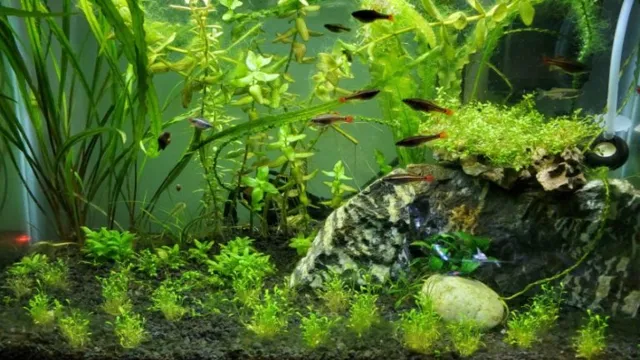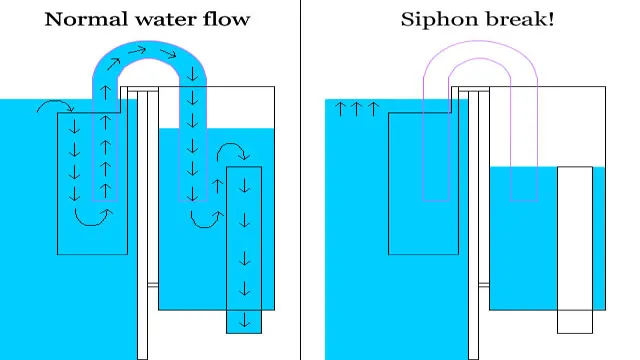As the temperature drops outside, many aquarium owners may wonder how their underwater pets will fare in the colder months. It’s important to remember that keeping an aquarium healthy in the winter requires some extra care and attention. But with a few adjustments and some basic maintenance, your fish and plants can thrive throughout the season.
So, what steps should you take to maintain your aquarium in the winter? Let’s dive in and explore some helpful tips and tricks to keep your aquatic environment in top shape during the colder months.
Check Temperature
Maintaining an aquarium in winter can be a challenging task, especially when it comes to ensuring that the temperature of the water remains optimal for the fish and plants. One of the key steps to achieve this is to regularly monitor the temperature using a reliable thermometer. It is important to keep in mind that fluctuations in temperature can be harmful to the inhabitants of the aquarium, so it is advisable to use heaters and other equipment to maintain a stable temperature.
In addition, it is important to check the temperature of the room where the aquarium is kept, as extreme cold or heat can affect the temperature of the water. By being vigilant and taking proactive steps to maintain the temperature, you can ensure that your aquarium thrives throughout the winter season. So, be sure to check the temperature regularly and take action as needed, using the appropriate tools and resources to keep your aquarium healthy and happy.
Use a Heater
If you’re feeling chilly at home, the first step is to check the temperature. It’s important to know how cold it is before deciding how to warm up. A simple way to do this is by using a thermometer.
Once you know the temperature, you can choose the appropriate method of heating. One option is to use a heater. There are several types of heaters available, such as space heaters, electric heaters, and gas heaters.
Each has its benefits and drawbacks, so it’s crucial to do your research and choose the one that suits your needs. For example, if you want to heat a large room quickly, a gas heater may be the best option. On the other hand, if you only need to warm up a small area, an electric space heater may be more efficient.
Regardless of which type of heater you choose, make sure to follow the safety instructions carefully to avoid accidents and stay warm and cozy all winter long.

Avoid Extreme Temperature Changes
Checking the temperature of the environment around you is important when it comes to preserving the condition of your valuables. Extreme temperature changes can cause damage to a variety of materials, including electronics, musical instruments, and artwork. It is therefore important to store these items in a location where the temperature is stable or to monitor the temperature of your storage area closely.
This is especially important during the summer and winter months when temperatures can fluctuate rapidly. Ensuring that the temperature is within a safe range will not only protect your valuables but also extend their lifespan. So, take the time to regularly check the temperature around your storage area and make adjustments as necessary to create a safe and stable environment for your precious items.
Water Quality and Chemistry
Keeping an aquarium in the winter can be a bit more challenging than in other seasons. But there are some tips and tricks that you can follow to maintain the water quality and chemistry during the winter months. First of all, make sure that the water temperature stays consistently between 74 and 78 degrees Fahrenheit as drastic changes in temperature can cause stress to the fish.
You can use a heater to regulate the water temperature. Additionally, monitor the pH level of the water to make sure that it stays between 5 and
In colder temperatures, the water can become more acidic, so adding crushed coral or a buffer to the tank can help maintain the pH level. It’s also important to keep a check on the nitrogen cycle in the tank, as the cold weather can impact the balance. (See Also: How to Clean Aquarium Pipes: Best Techniques and Tips for Sparkling Clear Water)
Perform regular water tests and partial water changes to ensure that the water remains healthy for your fish. By following these tips, you can maintain a healthy and thriving aquarium even during the chilly winter months.
Monitor Water Parameters
Water parameters refer to the various physical, chemical, biological, and other characteristics of water that are significant for indicating its suitability for various purposes. In other words, water quality refers to the degree of purity and characteristics of the water we consume and use in our daily lives. Monitoring water quality is crucial to ensure that the water is fit for consumption, as different contaminants can affect the safety and quality of water significantly.
Regular monitoring of water parameters such as pH, temperature, turbidity, dissolved oxygen, and nutrient levels can ensure that the water is free from toxic chemicals, bacteria, viruses, and other harmful microorganisms that can be harmful to your health. In summary, monitoring water quality and chemistry is vital in ensuring that the water we consume and use in our daily lives is safe and fit for purpose.
Perform Water Changes
Perform Water Changes: Ensuring Good Water Quality and Chemistry for Your Aquarium Maintaining good water quality and chemistry in your aquarium is crucial to the health and well-being of your fish and aquatic plants. One important way to achieve this is by performing regular water changes. But how often should you change the water? Well, that depends on a few factors, such as the size of your tank, the number and type of fish you have, and the filtration system you’re using.
As a general rule, it’s recommended to do a 10-15% water change every week for a small tank (under 20 gallons) and a 20-25% change for larger tanks. For heavily stocked tanks, a weekly 25-50% water change is recommended. The process of changing the water is pretty straightforward.
First, turn off the equipment (filters, heaters, etc.) to prevent any accidents. Then, using a siphon hose and bucket, remove the water from the tank, being careful not to disturb the substrate or decorations.
Once you’ve removed the desired amount of water, refill the tank with fresh, conditioned water at the same temperature as the aquarium. Why is changing the water so important? Well, over time, fish waste, excess food, and other organic matter build up in the water, contributing to ammonia and nitrite levels (toxic to fish) and lowering the pH. In addition, tap water often contains dissolved minerals and metals that accumulate in the tank and can harm fish.
Regular water changes help dilute these harmful substances and keep the water clean and healthy. In sum, performing regular water changes is a simple but crucial aspect of maintaining good water quality and chemistry in your aquarium. So next time you do a water change, remember that you’re not just removing water – you’re taking an important step towards ensuring the health and happiness of your aquatic pets.
Add Aquarium Salt
When it comes to aquarium maintenance, ensuring the water quality and chemistry is crucial for the health and wellbeing of your aquatic pets. One method of achieving this is by adding aquarium salt to the water. Not only does aquarium salt help to reduce stress levels in your fish, but it also aids in their osmoregulation process – the ability to maintain a balance of salt and water in their bodies.
Additionally, adding aquarium salt can help to prevent common fish diseases, such as ich. However, it’s important to note that not all fish species can tolerate salt in their water, so be sure to do your research and consult a professional before adding aquarium salt to your tank. With proper care and attention, adding aquarium salt can be a beneficial addition to your aquarium maintenance routine.
Feeding and Fish Care
If you’re a fish enthusiast, you know that maintaining an aquarium during winter can be challenging. However, with proper care, you can keep your fish healthy and happy all year round. Firstly, it is essential to regulate the temperature of the water to maintain a consistent temperature. (See Also: How to Make Rock Formations for Aquariums: A Step-by-Step Guide for Stunning Underwater Landscapes)
The best temperature range for most fish is between 75-80 degrees Fahrenheit. Secondly, ensure to feed your fish at the same time every day, and only feed them as much as they can consume in a few minutes. Overfeeding can lead to harmful waste buildup, which can cause health issues.
Lastly, it’s vital to monitor the water quality by regularly testing the pH and nitrate levels. Additionally, cleaning the aquarium every two weeks can prevent the growth of bacteria and keep the water fresh and clean. By following these simple tips, you can successfully maintain your aquarium during winter and provide your fish with a healthy and comfortable environment.
Adjust Feeding Schedule
As a responsible fish owner, one of your primary concerns is ensuring that your aquatic pets receive the proper nutrition they need to thrive. To achieve this goal, you must establish a regular feeding schedule that fits your fish’s dietary requirements. If you are new to fish care, it is crucial to research your fish’s feeding habits to determine how often and how much you should feed them.
Additionally, you should avoid overfeeding, which can lead to health problems and water pollution. Suppose your fish appear to be constantly begging for food, despite being adequately fed. In that case, it might be time to readjust their feeding schedule.
You can try spreading out their meals throughout the day or feeding them smaller portions more frequently. Remember, every fish species has unique eating habits, so it’s essential to research the best feeding schedule for your fish. By adjusting their feeding schedule, you can keep your aquatic pets happy and healthy for years to come.
Provide Adequate Lighting
Proper lighting is critical when it comes to feeding and caring for fish. Whether you have a freshwater tank or a saltwater aquarium, the right lighting can promote healthy growth and food intake in your fish, while inadequate lighting can lead to sickness and malnutrition. The type of lighting you choose depends on your fish species and the type of plants you have in your tank.
Most importantly, your lighting should mimic natural daylight to provide your aquatic life with the appropriate amount of light necessary for growth and development. Additionally, consider the intensity of the light and the duration it should be used each day. Providing adequate lighting for your fish is one small step that can make a significant difference in their overall wellness and vibrant coloration.
So, don’t overlook the significance of lighting when it comes to your fish care routine, and ensure that you’re using the proper lighting to promote the health of your aquatic pets.
Prepare for Power Outages
If you’re an aquarium owner, you know how important it is to keep your tank stable and healthy – especially during the winter months when power outages can occur. The first step in preparing for power outages is to invest in a battery-operated air pump. This will ensure that your fish have enough oxygen while the power is out.
It’s also a good idea to have a backup heater and thermometer on hand to maintain the proper water temperature. If you live in an area prone to frequent power outages, consider investing in a generator or UPS backup power supply to keep your aquarium running smoothly. Additionally, make sure to have plenty of blankets and towels on hand to insulate the tank and prevent heat loss.
By taking these simple steps, you can prepare your aquarium for a power outage and ensure the health and happiness of your aquatic friends all winter long.
Conclusion
In conclusion, maintaining an aquarium in winter requires a bit of extra effort, but it’s worth it to keep your fish happy and healthy. Just like we bundle up in winter clothes, we need to also make sure our fish have the proper insulation and heat to survive the colder months. Give them a cozy home, keep their water temperature stable, and make sure they’re getting the right nutrients to thrive. (See Also: How to Make Aquarium Tank: A Step-by-Step Guide for Beginners)
And remember, just because it’s cold outside doesn’t mean you can’t enjoy the beauty of your aquarium year-round!”
FAQs
How often should I change the water in my aquarium during winter?
During winter, you should change 25% of the aquarium water every 2-3 weeks. This prevents any toxic substances from building up in the water.
Can I use a heater in my aquarium during winter?
Yes, a heater is essential in maintaining the right temperature for your fish during winter. Make sure to check the temperature regularly to ensure it stays within the recommended range.
Should I adjust my fish feeding schedule during winter?
Yes, you may need to adjust the feeding schedule as some fish tend to eat less in colder temperatures. Feed them once a day and only what they can eat in 2-3 minutes.
Is it necessary to add an aquarium salt during winter?
Yes, adding aquarium salt during winter can help reduce stress in fish and prevent diseases. Use only the recommended amount based on the size of your tank.
What types of fish are suitable for cold water aquariums during winter?
Some cold water fish that are suitable for aquariums during winter include goldfish, koi, and guppies.
How can I prevent algae growth in my aquarium during winter?
You can limit algae growth by avoiding overfeeding, reducing the amount of light exposure, and maintaining the right PH levels in the water.
What steps can I take to maintain a healthy aquarium environment during winter?
Some steps include regular water changes, using a heater, ensuring proper filtration, monitoring the temperature and PH levels, and maintaining a healthy feeding routine.







